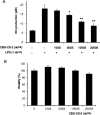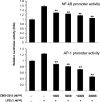Anti-inflammatory effects of Cordyceps mycelium (Paecilomyces hepiali, CBG-CS-2) in Raw264.7 murine macrophages
- PMID: 25814919
- PMCID: PMC4371127
- DOI: 10.1007/s13596-014-0173-3
Anti-inflammatory effects of Cordyceps mycelium (Paecilomyces hepiali, CBG-CS-2) in Raw264.7 murine macrophages
Abstract
Cordyceps (CS) is a traditional Chinese herb with various biological effects that include immune modulation. CBG-CS-2 is a strain, Paecilomyces hepiali, of the Cordyceps spp. The anti-inflammatory effects of CBG-CS-2 were investigated. The water-soluble fraction of CBG-CS-2 has high anti-inflammatory activity in LPS-induced Raw264.7 macrophages. We tested the role of CBG-CS-2 on the anti-inflammation cascade in LPS-stimulated Raw264.7 cells. CBG-CS-2 significantly decreased NO production, iNOS expression, and pro-inflammatory cytokine secretion in a dose-dependent manner. To investigate the mechanism by which CBG-CS-2 inhibits NO, iNOS, and pro-inflammatory cytokines, we examined the activities of NF-κB and AP-1 in LPS-activated macrophages. The results demonstrate that CBG-CS-2 suppresses the production and expression of NO, iNOS, and pro-inflammatory cytokines in LPS-activated macrophages via inhibition of NF-κB and AP-1, which may play an important role in inflammation. These findings suggest that CBG-CS-2 has modulatory effects on the inflammatory system in macrophages, and that it can serve as a useful anti-inflammatory dietary supplement or drug.
Keywords: Anti-inflammation; CBG-CS-2; Cordyceps; Paecilomyces hepiali.
Conflict of interest statement
The authors have declared that no conflict of interest.
Figures




Similar articles
-
Immunomodulatory effects of a mycelium extract of Cordyceps (Paecilomyces hepiali; CBG-CS-2): a randomized and double-blind clinical trial.BMC Complement Altern Med. 2019 Mar 29;19(1):77. doi: 10.1186/s12906-019-2483-y. BMC Complement Altern Med. 2019. PMID: 30925876 Free PMC article. Clinical Trial.
-
Er-Miao-San, a traditional herbal formula containing Rhizoma Atractylodis and Cortex Phellodendri inhibits inflammatory mediators in LPS-stimulated RAW264.7 macrophages through inhibition of NF-κB pathway and MAPKs activation.J Ethnopharmacol. 2014 Jul 3;154(3):711-8. doi: 10.1016/j.jep.2014.04.042. Epub 2014 May 6. J Ethnopharmacol. 2014. PMID: 24815219
-
Anti-inflammatory Potential of Petiveria alliacea on Activated RAW264.7 Murine Macrophages.Pharmacogn Mag. 2017 Jul;13(Suppl 2):S174-S178. doi: 10.4103/pm.pm_479_16. Epub 2017 Jul 11. Pharmacogn Mag. 2017. PMID: 28808377 Free PMC article.
-
Schisandra Chinensis Lignans Suppresses the Production of Inflammatory Mediators Regulated by NF-κB, AP-1, and IRF3 in Lipopolysaccharide-Stimulated RAW264.7 Cells.Molecules. 2018 Dec 14;23(12):3319. doi: 10.3390/molecules23123319. Molecules. 2018. PMID: 30558163 Free PMC article.
-
Foenumoside B isolated from Lysimachia foenum-graecum extract suppresses LPS-induced inflammatory response via NF-κB/AP-1 inactivation in murine macrophages and in endotoxin-induced shock model.Eur J Pharmacol. 2018 Aug 5;832:120-128. doi: 10.1016/j.ejphar.2018.05.022. Epub 2018 May 18. Eur J Pharmacol. 2018. PMID: 29782861
Cited by
-
In silico and in vitro design of cordycepin encapsulation in liposomes for colon cancer treatment.RSC Adv. 2021 Feb 25;11(15):8475-8484. doi: 10.1039/d1ra00038a. eCollection 2021 Feb 23. RSC Adv. 2021. PMID: 35423402 Free PMC article.
-
Cordyceps sinensis inhibits airway remodeling in rats with chronic obstructive pulmonary disease.Exp Ther Med. 2018 Mar;15(3):2731-2738. doi: 10.3892/etm.2018.5777. Epub 2018 Jan 19. Exp Ther Med. 2018. PMID: 29456676 Free PMC article.
-
Anti-inflammation effects of 8-oxo-9-octadecenoic acid isolated from Undaria peterseniana in lipopolysaccharide-stimulated macrophage cells.EXCLI J. 2018 Aug 2;17:775-783. doi: 10.17179/excli2018-1422. eCollection 2018. EXCLI J. 2018. PMID: 30190667 Free PMC article.
-
Prevention and Treatment of Osteoporosis Using Chinese Medicinal Plants: Special Emphasis on Mechanisms of Immune Modulation.J Immunol Res. 2018 Feb 20;2018:6345857. doi: 10.1155/2018/6345857. eCollection 2018. J Immunol Res. 2018. PMID: 29675436 Free PMC article. Review.
-
Extract of Paecilomyces hepiali mycelia induces lipolysis through PKA-mediated phosphorylation of hormone-sensitive lipase and ERK-mediated downregulation of perilipin in 3T3-L1 adipocytes.BMC Complement Altern Med. 2018 Dec 7;18(1):326. doi: 10.1186/s12906-018-2389-0. BMC Complement Altern Med. 2018. PMID: 30526586 Free PMC article.
References
-
- Jin CY, Kim GY, et al. Induction of apoptosis by aqueous extract of Cordyceps militaris through activation of caspases and inactivation of Akt in human breast cancer MDA-MB-231 cells. J Microbiol Biotechnol. 2008;18(12):1997–2003. - PubMed
LinkOut - more resources
Full Text Sources
Other Literature Sources
Research Materials
Miscellaneous
